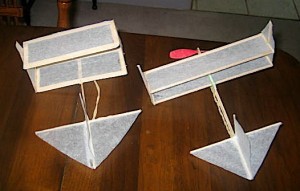
Submission from George Clark:
“I took a crack at building a very small Squirrel. It is challenging to get such a small plane to fly correctly. This is the second small Squirrel I have built and is another solid balsa plane. It is obvious that this is the lower size limit for the design. Currently, I am powering it with 2 strands of 1/8 rubber and a lightweight 5 in. plastic prop. Total weight with rubber, is 5.5 grams, the prop constituting 1.8 grams of that total. The rubber is too much for the plane, so I will be reducing it to a single strand of 1/8. The prop is also too large. A 4 in. or even 3 in. prop would be better. I have a 3 in. balsa prop that may work.
 Regardless, the plane flies as is, albeit nearly straight up and pirouetting as it does so. In the one of the attached photos, you can just see the plane scooting over a neighbour’s roof. Thankfully, it circled back. I was only able to get one flight photo as it was really moving. The wing chord is currently 1.5 in., with a span of 10 in. I may increase the chord to 2 in. or perhaps even 2.5 in. and see if the result will settle the flight characteristics a bit.”
Regardless, the plane flies as is, albeit nearly straight up and pirouetting as it does so. In the one of the attached photos, you can just see the plane scooting over a neighbour’s roof. Thankfully, it circled back. I was only able to get one flight photo as it was really moving. The wing chord is currently 1.5 in., with a span of 10 in. I may increase the chord to 2 in. or perhaps even 2.5 in. and see if the result will settle the flight characteristics a bit.”



